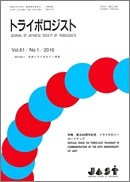Volume 66, Issue 8
Special Issue on Lubrication Technology in Metal Processing
Displaying 1-13 of 13 articles from this issue
- |<
- <
- 1
- >
- >|
Announcement
-
2021 Volume 66 Issue 8 Pages K8
Published: August 15, 2021
Released on J-STAGE: August 15, 2021
Download PDF (1629K)
Contents
-
2021 Volume 66 Issue 8 Pages M8
Published: August 15, 2021
Released on J-STAGE: August 15, 2021
Download PDF (212K)
Messages to Tribologists
-
2021 Volume 66 Issue 8 Pages 599
Published: August 15, 2021
Released on J-STAGE: August 15, 2021
Download PDF (319K)
Special Issue on Lubrication Technology in Metal Processing
-
2021 Volume 66 Issue 8 Pages 600
Published: August 15, 2021
Released on J-STAGE: August 15, 2021
Download PDF (171K)
Explanation
-
2021 Volume 66 Issue 8 Pages 601-607
Published: August 15, 2021
Released on J-STAGE: August 15, 2021
Download PDF (882K) -
2021 Volume 66 Issue 8 Pages 608-613
Published: August 15, 2021
Released on J-STAGE: August 15, 2021
Download PDF (4379K) -
2021 Volume 66 Issue 8 Pages 614-619
Published: August 15, 2021
Released on J-STAGE: August 15, 2021
Download PDF (4305K) -
2021 Volume 66 Issue 8 Pages 620-625
Published: August 15, 2021
Released on J-STAGE: August 15, 2021
Download PDF (1838K) -
2021 Volume 66 Issue 8 Pages 626-631
Published: August 15, 2021
Released on J-STAGE: August 15, 2021
Download PDF (1954K) -
2021 Volume 66 Issue 8 Pages 632-637
Published: August 15, 2021
Released on J-STAGE: August 15, 2021
Download PDF (1867K)
Explanation
-
2021 Volume 66 Issue 8 Pages 638-645
Published: August 15, 2021
Released on J-STAGE: August 15, 2021
Download PDF (3941K)
Original Contribution on Science
-
2021 Volume 66 Issue 8 Pages 646-655
Published: August 15, 2021
Released on J-STAGE: August 15, 2021
Advance online publication: June 09, 2021Download PDF (1914K)
Report of the Society
-
2021 Volume 66 Issue 8 Pages 656-657
Published: August 15, 2021
Released on J-STAGE: August 15, 2021
Download PDF (342K)
- |<
- <
- 1
- >
- >|
